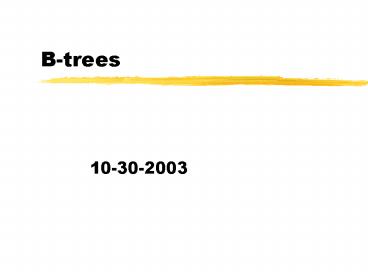Btrees - PowerPoint PPT Presentation
Title:
Btrees
Description:
The disk can have multiple platters that spin with read/write heads that hover ... One ring on a platter is a track, a stack of tracks in a cylinder. ... – PowerPoint PPT presentation
Number of Views:51
Avg rating:3.0/5.0
Title: Btrees
1
B-trees
- 10-30-2003
2
Opening Discussion
- Do you have any questions about the quiz?
- What did we talk about last class?
- Do you have any questions about the assignment?
- Group meetings and final format.
3
Some Details on Disks
- As you are well aware, your computer has both
internal memory and disks. Typically the disks
are much bigger (storage wise), but they are also
MUCH slower. - The disk can have multiple platters that spin
with read/write heads that hover over (and under)
the platters. - One ring on a platter is a track, a stack of
tracks in a cylinder. Cylinders are borken into
pages.
4
B-Trees
- The biggest difference between a B-tree and the
binary search trees we have looked at is the
branching factor. A B-tree will typically have
hundreds or thousands of children under a given
node. - The reason for this is that a node should fill a
page on disk. This optimizes the disk
operations. B-tree applications typically dont
fit in memory.
5
Requirements of a B-Tree
- Each node has a number of keys, the set of keys
stored in non-decreasing order and a boolean
saying if it is a leaf. - All internal leaves also have children, one more
than the key count. The fall between the keys
in that node and the keys in the children are
between the parent keys. - All leaves have the same depth.
- There is a minimum degree, t. All nodes (except
the root) must have at least t-1 keys and at most
2t-1 keys.
6
Searching a B-Tree
- The procedure of searching a B-tree is quite
simple. It is like a binary tree, except that at
each node we have to walk though multiple keys to
find either the one we want, or the two that
bound what we want. - If we find two that bound what we want we have to
load in the data for that child from disk and
recurse to that child.
7
Inserting into a B-Tree
- As with inserting into a binary tree, an
insertion to a B-tree can be done with a single
pass down through the tree that works much like a
search. The difference is that now we arent
adding a new node at the bottom. Instead, we add
the key in a leaf. - The problem is when a leaf is full we cant add
more. So we split.
8
Splitting
- The actual procedure we use is that as we go
down, any time we see a full child, we split it.
This way we do things in one pass. - To split a node, we add the median key in it to
its parent and turn it into two children of that
parent, each with half as many nodes. - When the root is full we split it by creating a
new root.
9
Minute Essay
- Combine what you know about direct access files
with what we just talked about for a B-tree.
Give a brief explanation of how you would
implement the internal code of a B-tree. How is
it different from what you have been doing with
our other trees? - Remember to do a group evaluation for assignment
3.































